Cropwell Bishop Streets: — Stockwell Lane (Updated: 6-3-22)
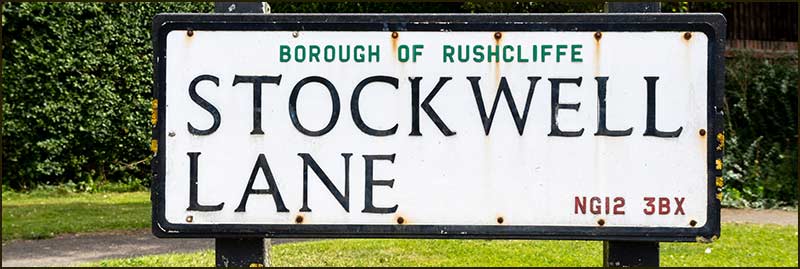
At the bottom of Stockwell Lane is the Pinfold, an ancient part of the village where there was once a pond fed by a spring.
However, once large-scale mining of gypsum occurred around the village in the 1900s, its water supply was disrupted and stopped appearing at the Pinfold.
The Pinfold, being at the centre of the village, was the natural place to put the village stocks: the punishment of miscreants was clearly more local and public in the past.
With stocks, and a fresh supply of spring water, you can see where the name ‘Stockwell Lane’ came from. But it wasn’t always called this.
For a long time – probably centuries – it was called Back Lane, and this is what it was called in the 1871 Census. Nevertheless, from 1881 it became known as Thraves Lane.
At that time, William Thraves, a tailor, and his wife Sarah, a dressmaker, lived on the Lane. Were they the source of the name, I wonder.
But their father had lived on the same lane since 1830, and during his lifetime (as a farm labourer), the lane was always known as Back Lane.
My guess is that because William and Sarah made clothes, people would have been regularly calling at their house and, consequently, their name became a more popular reference to the lane than Back Lane – hence it became known as Thraves Lane.
When Sarah died in 1910, no one with the name, Thraves, lived on the lane but the name persisted until at least 1939.
I don't know when Stockwell Lane became the new name but it is interesting to note that even in 1911 some homes in the village were referred to as Stockwell Cottages.
The road was made one-way in the 1960s.
These days, we see no reason for our street names to change, but that clearly wasn't the case in past times.

Maps

Note the narrow lane that leads south from near the Pinfold. In later years, the present cottages, 2-6 Stockwell Lane, were built along this lane.
Note also, how the short lane that currently leads up to the school gate, was once a much longer one with several buildings along its length.
People would have used this lane to collect water from the spring in the field beyond.
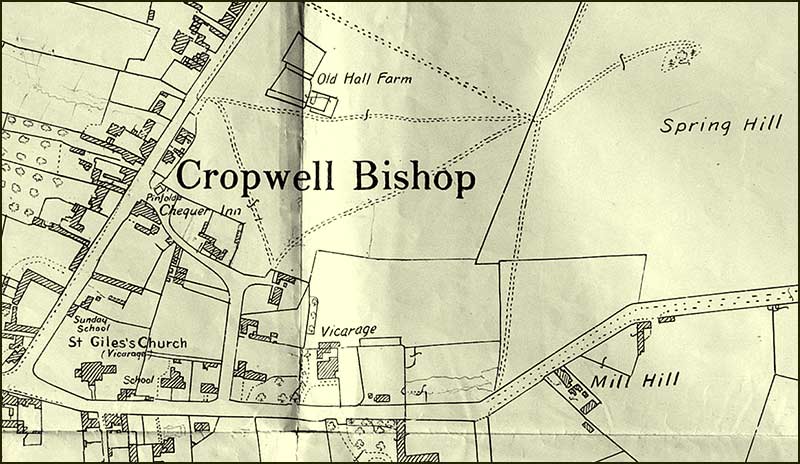
Note the location of the spring on Spring Hill.
The three cottages, 2-6 Stockwell Lane, are shown. The long narrow building that is beside the path to these homes, is the outdoor-toilet and wash-house block for the homes. It is no longer there.

Little changed in the twenty years before 1960: a great deal changed in the twenty years that followed. The same was probably true in most of Britain.
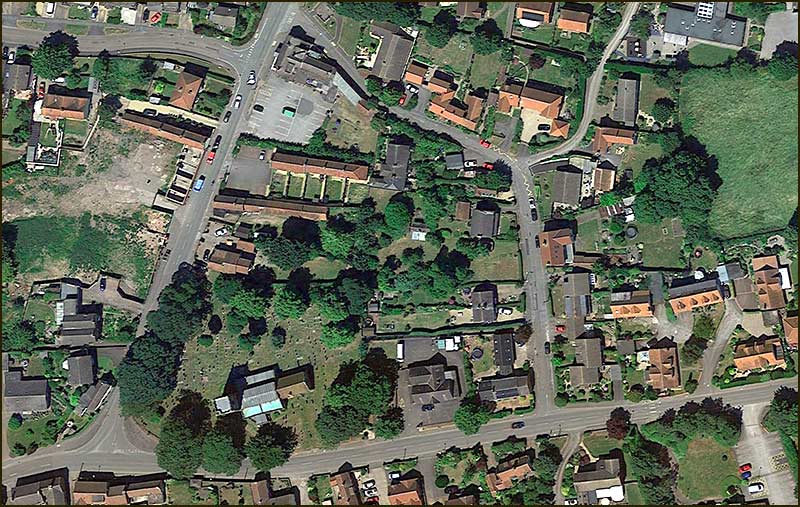

Church Views
Before drones were invented to take aerial photos, we had to make use of satellite images, and before that airplane and helicopter photos.
Before all of these, the people of Cropwell Bishop were fortunate in being able to see their village from above by climbing up the church tower (on the inside!) – and it is still a good way to get high resolution photos. Trees are the biggest problem but at least in winter they don't have leaves.
This colour photo was taken in November 2019.
It becomes more interesting when you compare it with photos taken many years ago and are able to spot changes that have happened in the interval.
The two black & white photos below were taken, I estimate, in the 1980s. Compare them with the 2020 photo and try to spot differences.
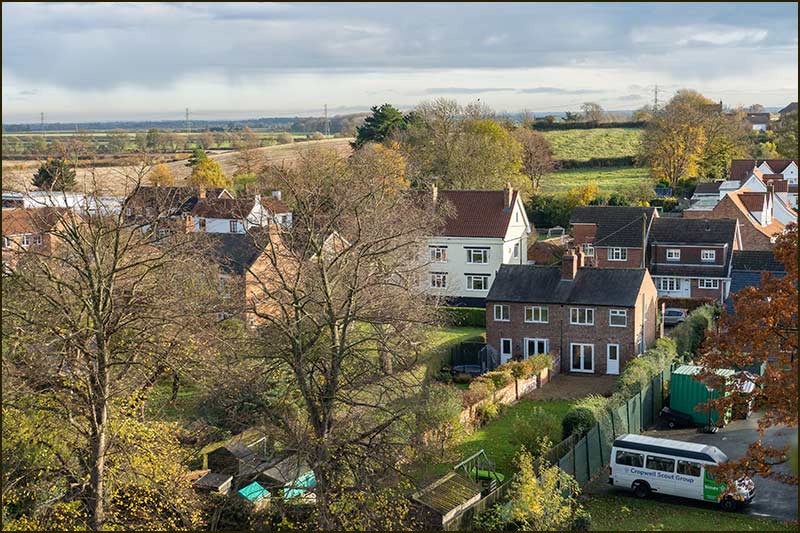
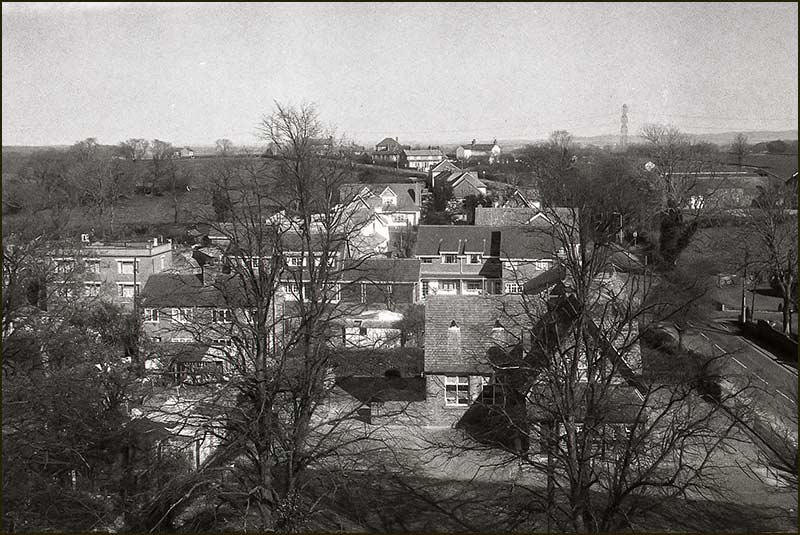
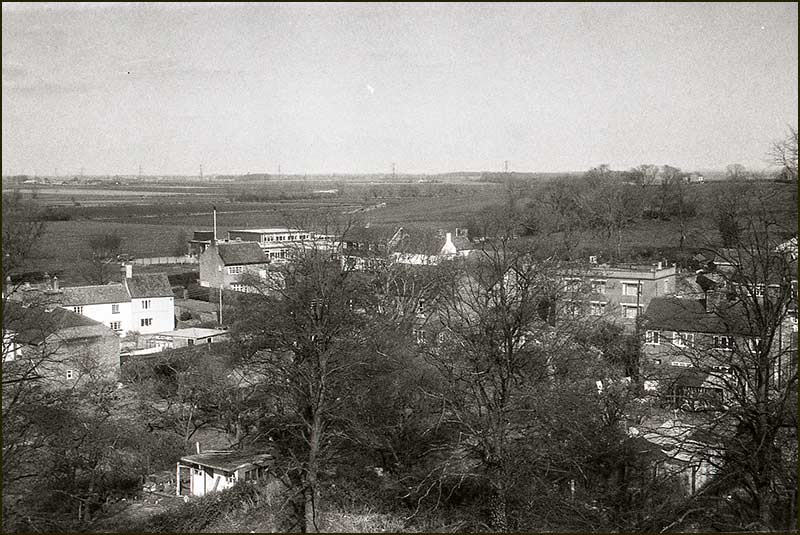

The Pinfold
The area we know as the Pinfold would probably be unrecognisable to the villagers who lived here a century or more ago.
Its name, Pinfold, relates to a time when there was a need to lock-up stray farm animals. In the early 1900s it existed as a low-walled pen with a gate, and was about 6m square. There was a lock on the gate.
A parish officer, called a Pinder, would lock stray animals in the Pinfold and only release them on the payment of a fine.
Near to the Pinfold in those days, stood the village stocks and there was also a pond fed by a spring. The pond would reach a depth of 30cm, or so, and then overflow into a nearby dyke.
With stocks and a fresh supply of spring water, you can see where the name ‘Stockwell Lane’ came from. But it wasn’t always called this. Previously it was known as Thraves Lane (after William and Sarah Thraves who lived there) and, before that, as Back Lane.
Even these days, people will sometimes refer to it as Back Lane without giving it a second thought, it being a perfect description and a bit easier on the tongue.
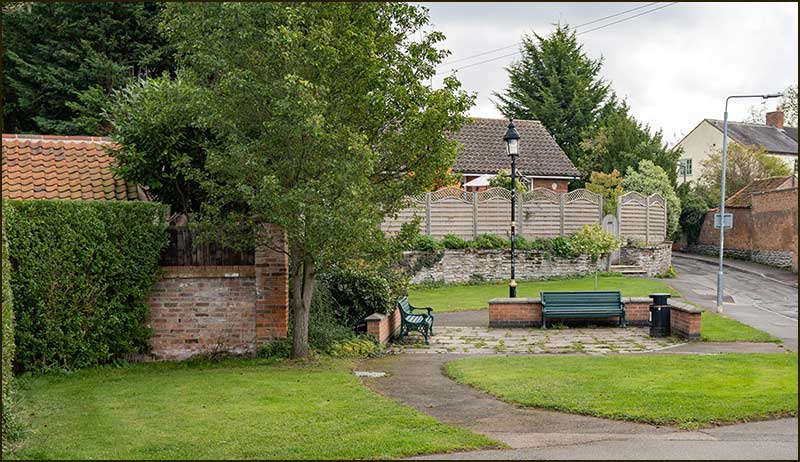



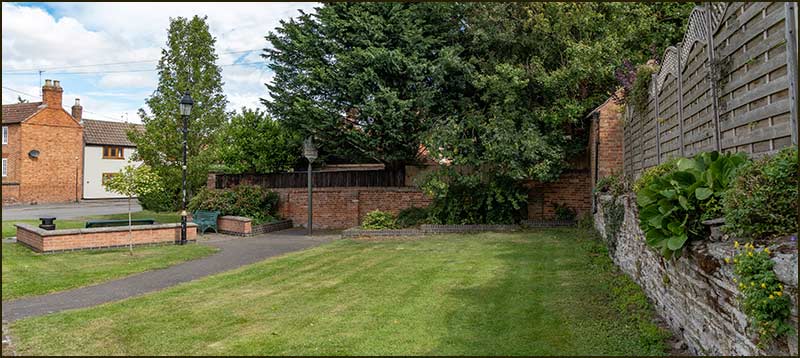
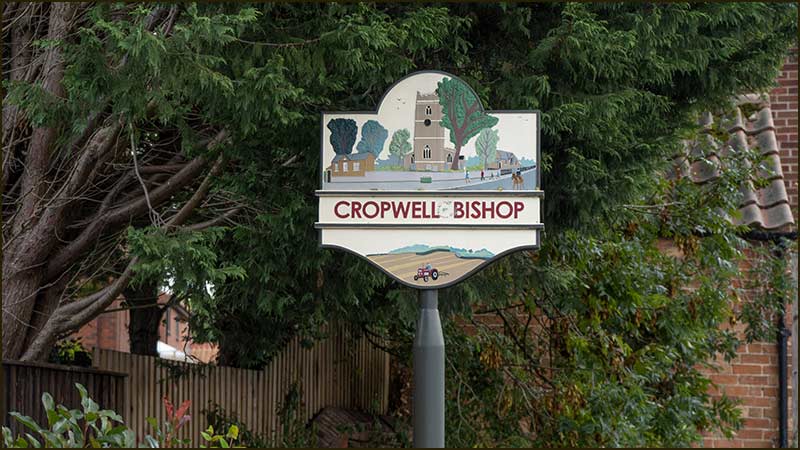

Up the Lane
Street, Road, Close, Avenue, Drive – all these words are used to describe streets.
With Avenue and Close, I picture a short, dead-end street, although I can't be certain (e.g. 5th Avenue in New York), but none of the rest, stimulate my imagination.
On the other hand, when it comes to Lane, I imagine something old, narrow, curvy, steep sided, with a narrow pavement - or none at all. In fact, to me, this photo of Stockwell Lane looks just how a lane should look.


In its raised position it looks as though it has the job of keeping an eye on the Pinfold.
One previous owner was Ethel Harper who, together with her husband, Aubrey Harper, wrote and published the local history book, Chronicles of Cropwell Bishop, back in 1988.
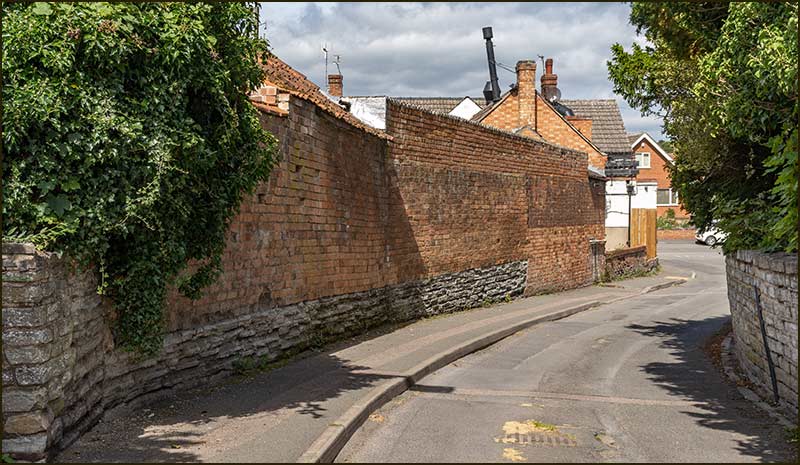
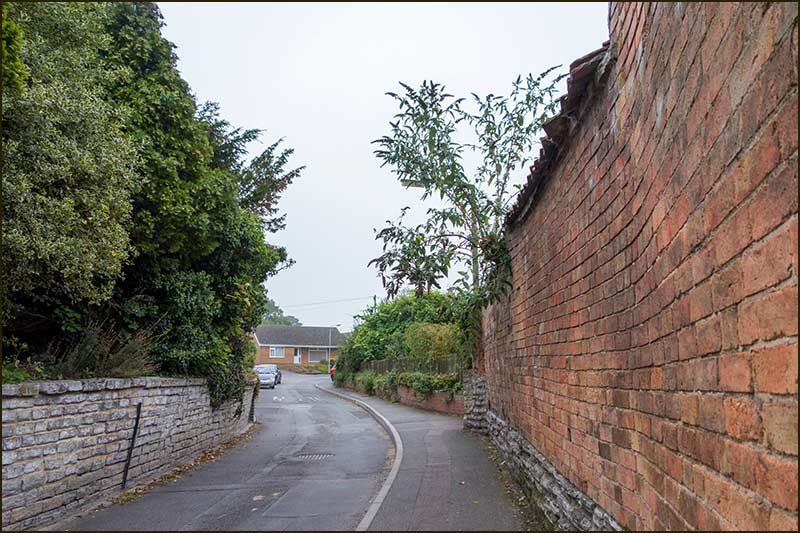
This photo was taken in 2014, but nothing much will have changed in 6 years: this is a real lane.


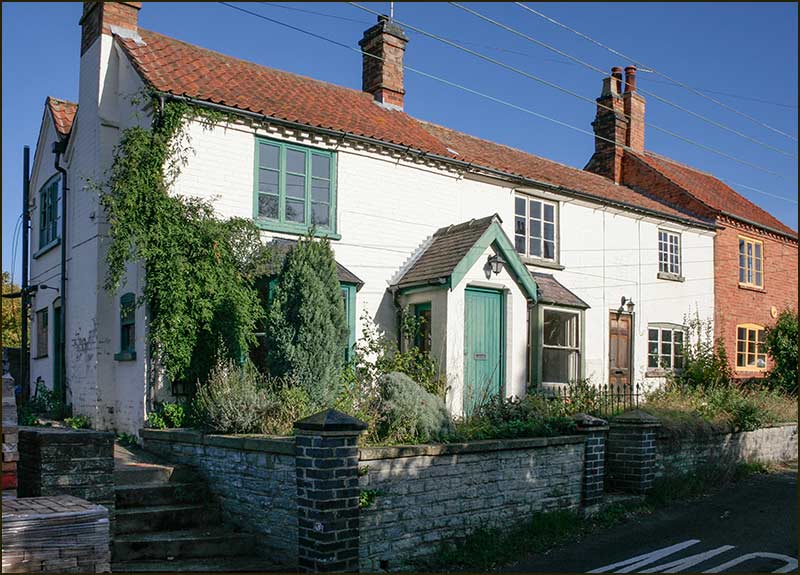
It was soon to be demolished and rebuilt. It had been the home of Margaret Kerr who had been a Parish Councillor. Kerrs Walk is named after her.
Number 3, next door, would also be part of the rebuild

The enlarged home is 1 Stockwell Lane: number 3 is now just a memory.
A modern, energy-efficient home has replaced old buildings but the style is very much is keeping with both former and nearby homes and enhances the appearance of the Lane.



(1950s)
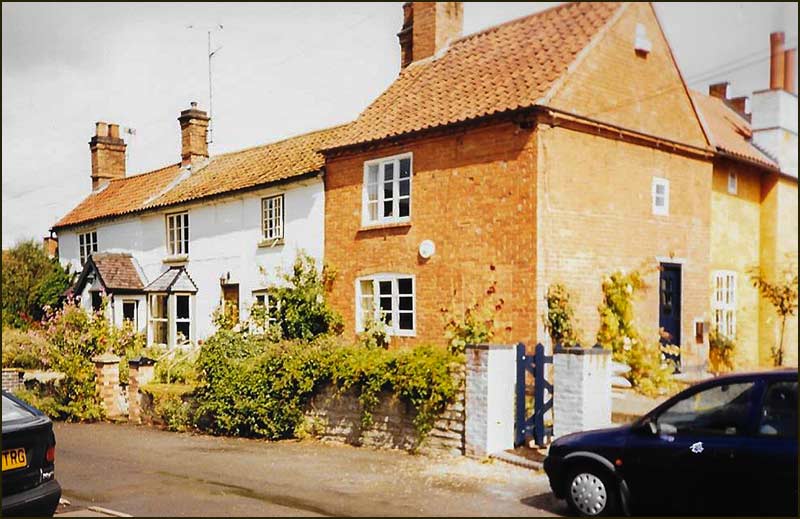
It looks as though it might have looked this way for centuries.
It just shows what is possible when you employ a good architect and builder.



On the Bend
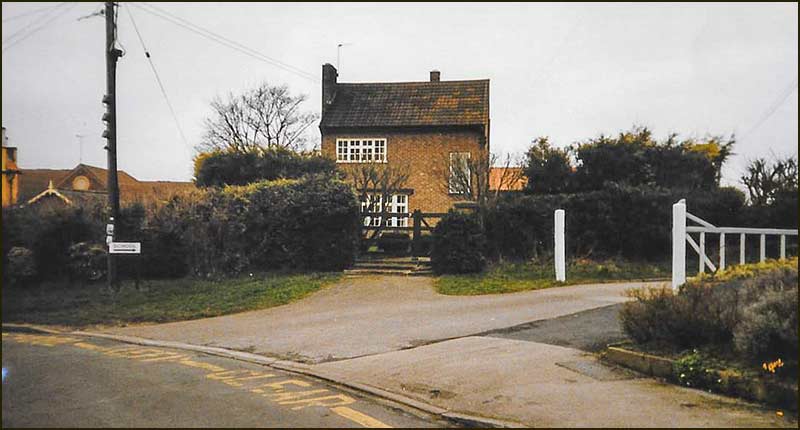
As we compare this photo with others, take your bearings from the School sign with its arrow: its position has hardly changed in 20 years, whilst most everything around it has.
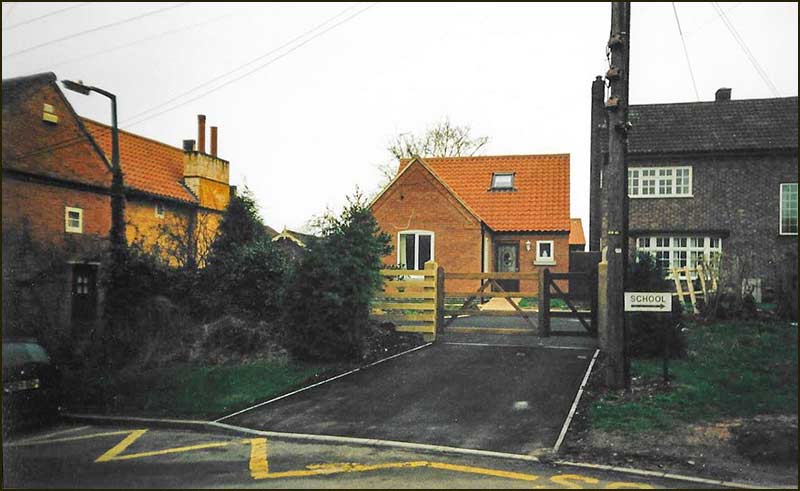
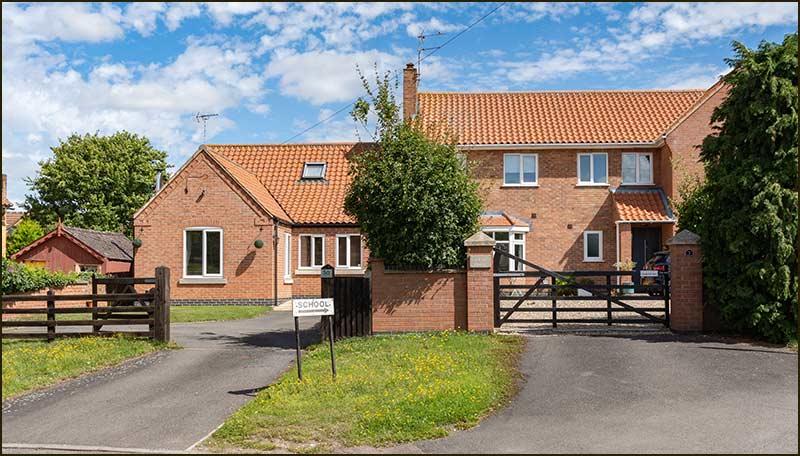
I think the appearance of the two new homes is a big improvement on the original house – and the insides will be vastly better.

For great views down the Lane, and red sunsets over the village, this is the place to live.

Dennis Baker
There is no School Lane but, if there was, this would be it (until, that is, the proposed new housing estate is built and the school creates a new entrance).
The School was built in 1961 and, once it opened, the School on Fern Road shut its doors for the last time. Compared with the School today, the new building was small: just look at this early photograph of it in its field behind Old Hall Farm.

In front is Old Hall Farm that was demolished to make way for Springfield Close.
The first Head of the School was Dennis Baker. He was able to keep a close eye on his School 24 hours a day: he lived in the house beside the school gates. As well as giving time to his school duties, he also served as a Parish Councillor.
He served as head for around 20 years but towards the end of that time, life gradually became more difficult for him after he was diagnosed with multiple sclerosis. Although he retired as Head, he did not retire from work for another 10 years.
The following paper-cutting describes his reaction to the diagnosis and how he and his wife, Muriel, took the advice given by doctors: do everything you want to do in the next 10 years. It looks like they did.
Round the world tours, holidays in China, house-swaps in Australia and Canada – Dennis and Muriel made the most of their time together.
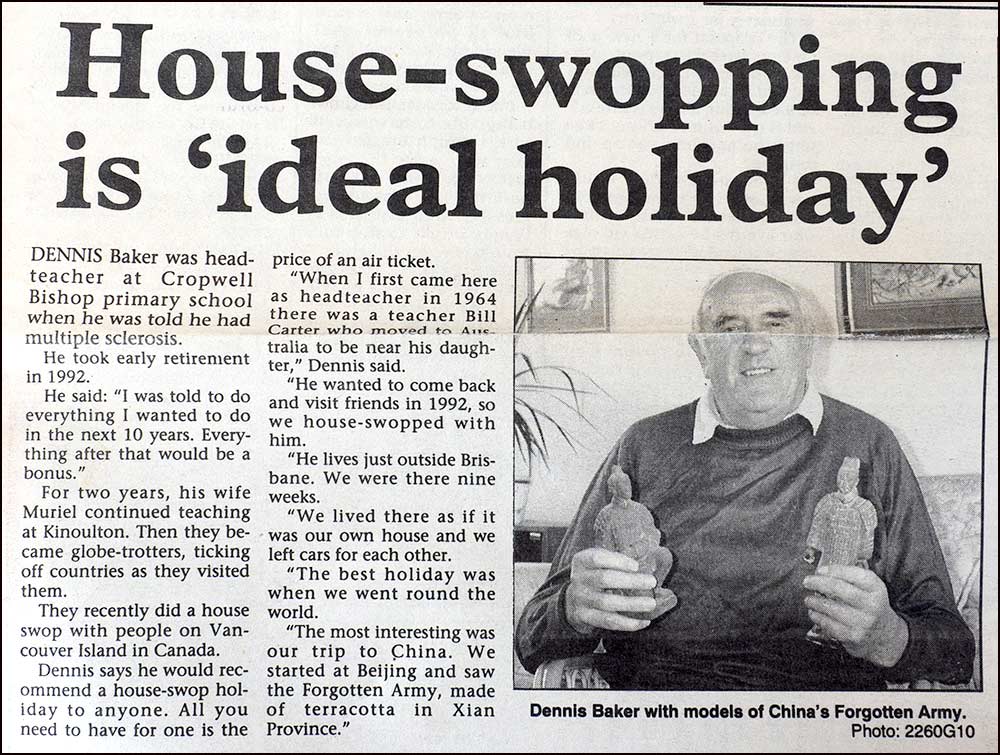
I suspect the shock of the MS diagnosis motivated them to do far more than they might have done if Dennis had enjoyed a life of good health. Maybe their reaction is a lesson for all of us.
Muriel, who in her younger years was a teacher at Kinoulton Primary School, can still be seen walking around Cropwell Bishop.

Taken at Cotgrave with Head, Dennis Baker

From left to right: Vic Hall, Arthur Barlow, John Foster, David Holmes (clerk), Harold Smith (chairman), Dennis Baker, John Dean and Tom Rawlings.



Ivy Cottage
Ivy Cottage has been standing near the bend on Stockwell Lane a long time, at least 140 years. It is one of the oldest buildings on the road and has experienced three name changes of the Lane.
Being just off the Lane, and looking like it is on a private drive, must pose problems for delivery people. At least when they see the bungalow next door is 9A, they will know that number 9 (Ivy Cottage) is not far away.
Delivery people are known to have far greater problems finding Springfield House next door; it hasn't even been granted its own house number.
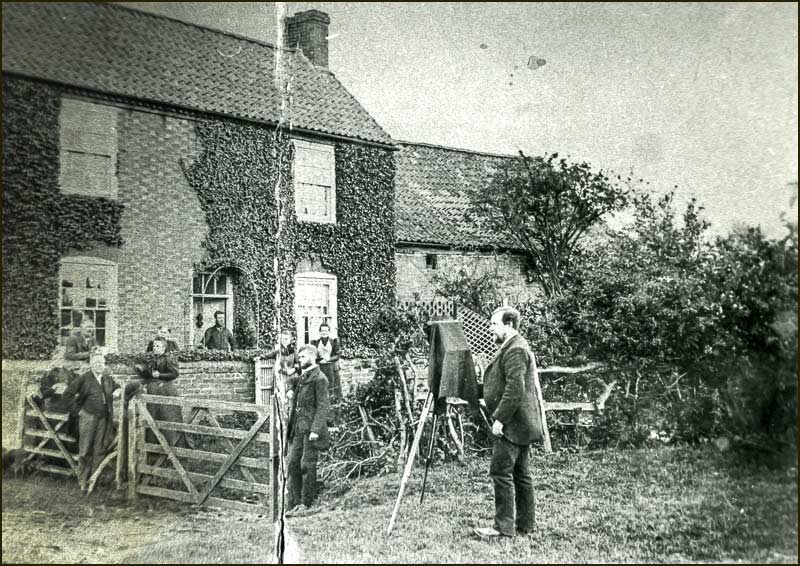
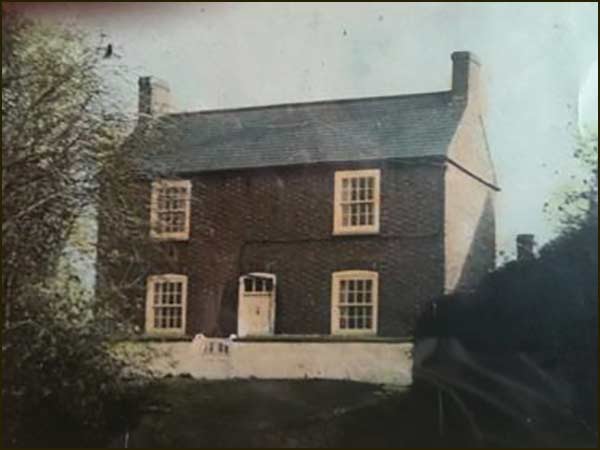

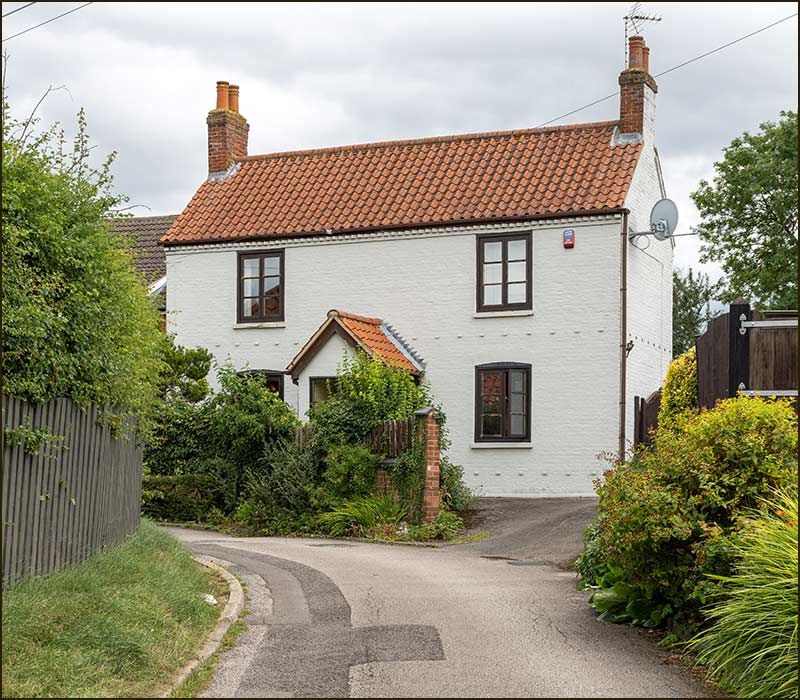

The Cottages, numbers 2, 4 and 6
There is a terrace of three cottages sandwiched between the back of The Chequers and the two flat-roofed garages on Stockwell Lane. It's a shame they are now partly hidden, because they once held a commanding presence on Stockwell Lane.
The garages hide the fronts of the homes, but the photo from the 1940s clearly shows the former extent of their front gardens and the apparent tranquillity they once enjoyed.
Where the garages now are, there would have been a long path from the house to the pavement on Stockwell Lane.
At one time, access to the front of the houses was also possible via steps from the lane – somewhere opposite number 1. A newish wall hides any trace of it in 2020.


The left-hand photo was taken from the same spot as the 2020 photo above (cottages 2 and 4 have been excluded).
The right-hand photo was taken from near the cream-coloured garage, with the camera pointing towards the Pinfold. On the left is number 2, and on the right is the front of number 1 (in its former state: it has since been rebuilt in a similar style)

The Plough and Harrow
Number 11 has an interesting history: it was once an “off-licence”. This means it was allowed to sell alcohol.
These days, when it seems like every other shop sells alcohol, the phrase is never heard, but before the 1970s, it was where you bought alcohol for drinking at home. Very often, it was a little shop or just a counter attached to a pub.
So, number 11 was a little pub with an off-licence counter. Or, you can think of it as a beer shop with a public bar. Its name was, The Plough and Harrow, but it was more commonly referred to as The Plough.
The building hides its past well, but then it is over a century since it sold its last pint of beer. During those hundred years it has been a private home and has changed its appearance several times, sometimes by choice and sometimes by accident.
Compare the photographs of it as The Plough in the 1890s (below), with its appearance in 1998 (below-right). The windows are all different in size and position and the door has gone. Not surprising really, who wants to have a front room looking like a public bar (don’t answer that).
But what has happened to the roof. Apparently, it was destroyed by fire in 1950. Who decided that a flat roof would look good is unknown, but the architects of the 1950s and 1960s do have a lot to answer for: many of their bleak and ugly buildings were demolished in the following decades although a few can still be seen festering in Nottingham and elsewhere.
Thankfully, a recent owner, roofed over the eyesore and, no doubt, created a few extra rooms in the process.
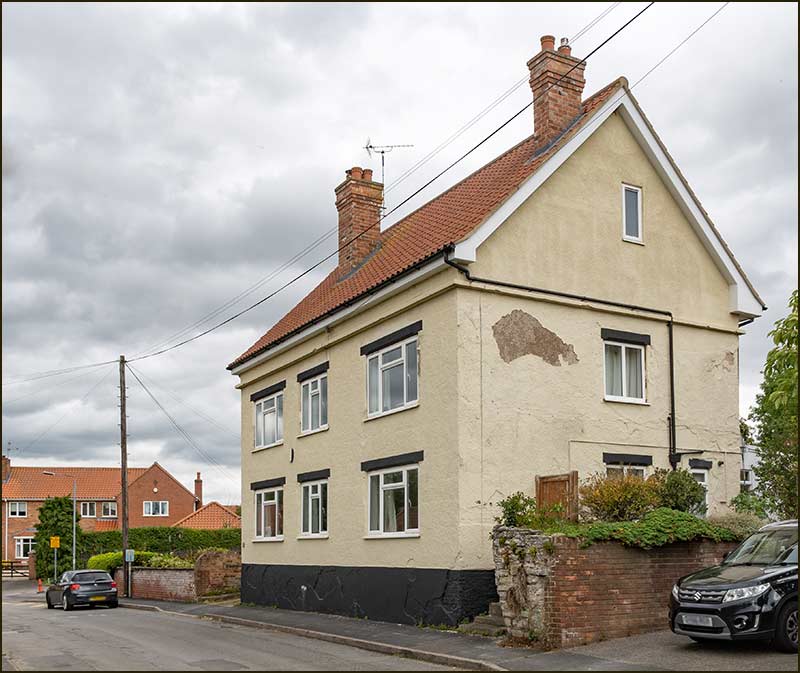
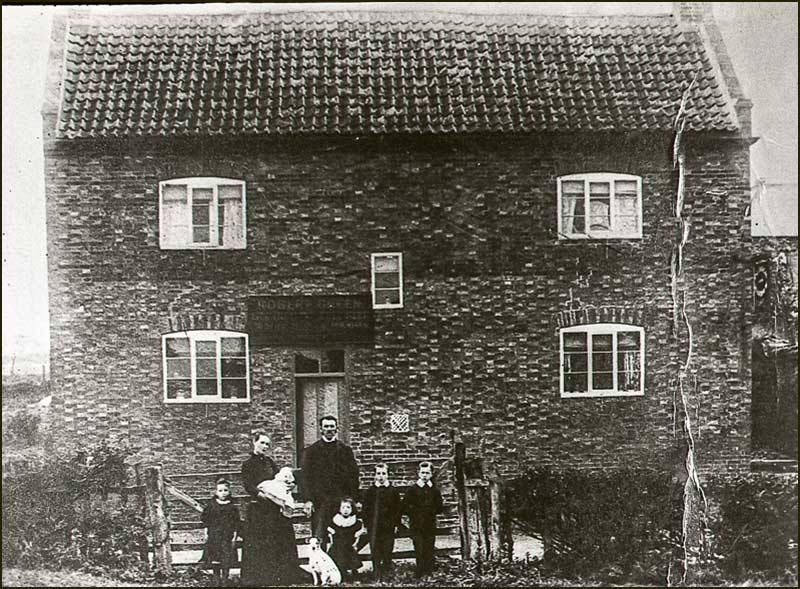
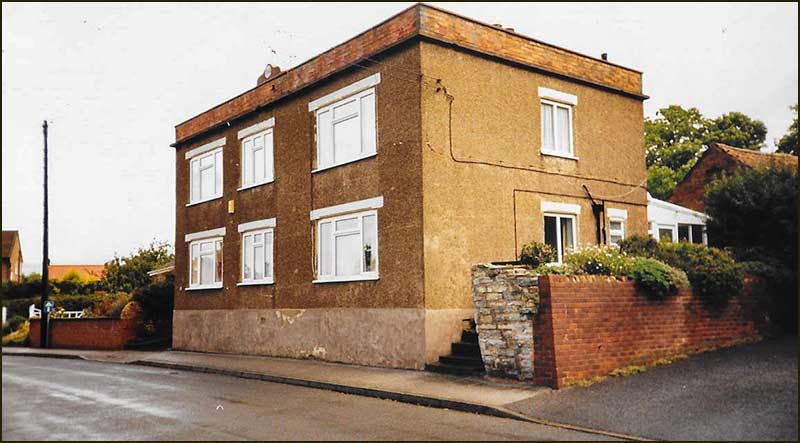

Groves Cottage
It was back in 1874 that Samuel Smith, of Hickling, married Cropwell Bishop girl, Elizabeth Shelton. They lived at a house at The Turn, which is the area in front of the Church.
As was common in Victorian times, they had a big family, seven children in all, but the one of interest in our story is their third, George Shelton Smith.
In 1903, when George was 25, he married 18-year-old Cropwell Bishop girl, Winifred Groves. Winifred's father was William Groves.
William was a Carrier. In the period from 1908 to 1912, he transported goods and people from Cropwell Bishop to Nottingham and back again every Saturday and Wednesday.
He was also an agent for the lace out-work that was done by villagers in their homes. He would do all the transporting between Nottingham and Cropwell Bishop.
Over 40 wives and daughters of the village spent their days doing finishing-work on the machine-made lace items manufactured in Nottingham. The piece rates of pay were low, but the money was welcome – especially for those married to low-paid agricultural labourers.
In 1906, William had a house built on the Lane. That house is number 8 Stockwell Lane and it has a plaque high on its wall: "Groves Cottage 1906". George and Winifred also lived in the house along with their growing family.
Groves Cottage was lived in by members of the Smith family for the whole of its history, from 1906 to 2022 when it was sold.
George and Winifred had six children; Florrie, George, William, Ethel, Harry and Harold. The second youngest, Harry, appears to have been an interesting character.
He worked as an aircraft assembler and we have a picture of him as a young man standing outside the Hairdresser on Church Street alongside his dog, Solomon.
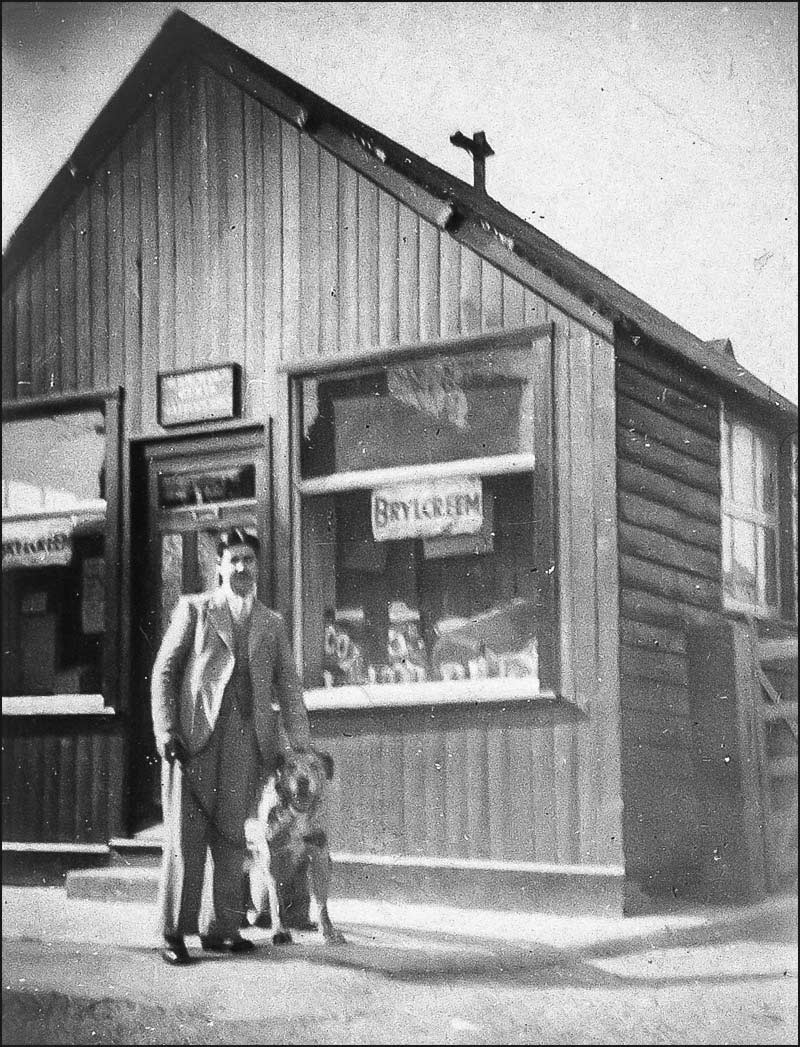
After marrying, he left the family home, Groves Cottage, to live his married life at 14 Stockwell Lane – just next door but one.
It was in 1946 that the nation learnt of Harry’s very unusual pet, a badger that he had rescued from a poacher’s trap and tamed.
Going on the bus from Cropwell Bishop to Nottingham was nothing out of the ordinary, but going with a pet badger was, and a photograph of him doing just that was printed in the national newspaper, the Daily Mirror.
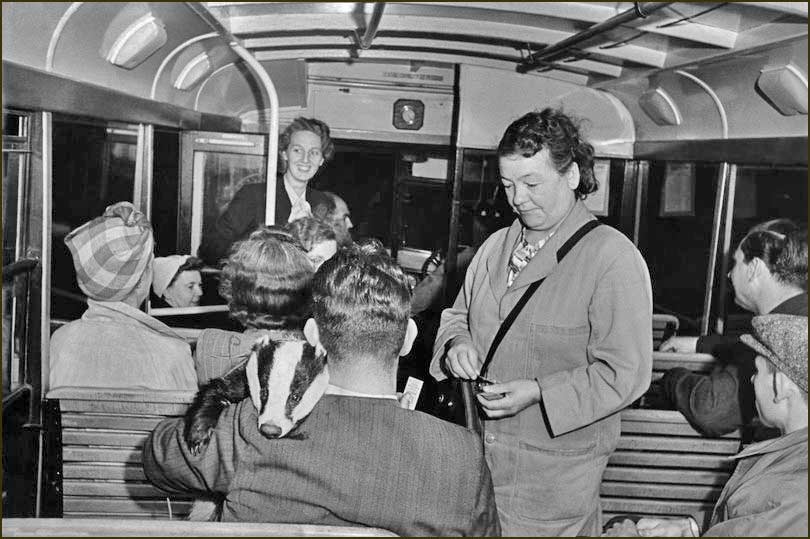
Another photo showed him walking alongside the Council House, on Cheapside, with Brock pulling him along.
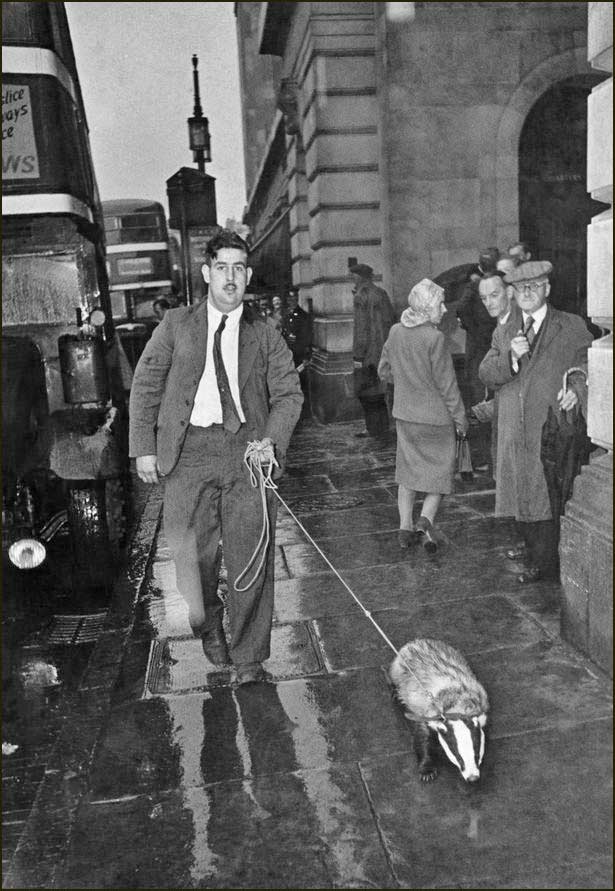
Back home, Brock lived as a member of the family, sleeping at night (wild badgers are nocturnal) and taking walks with the dog.
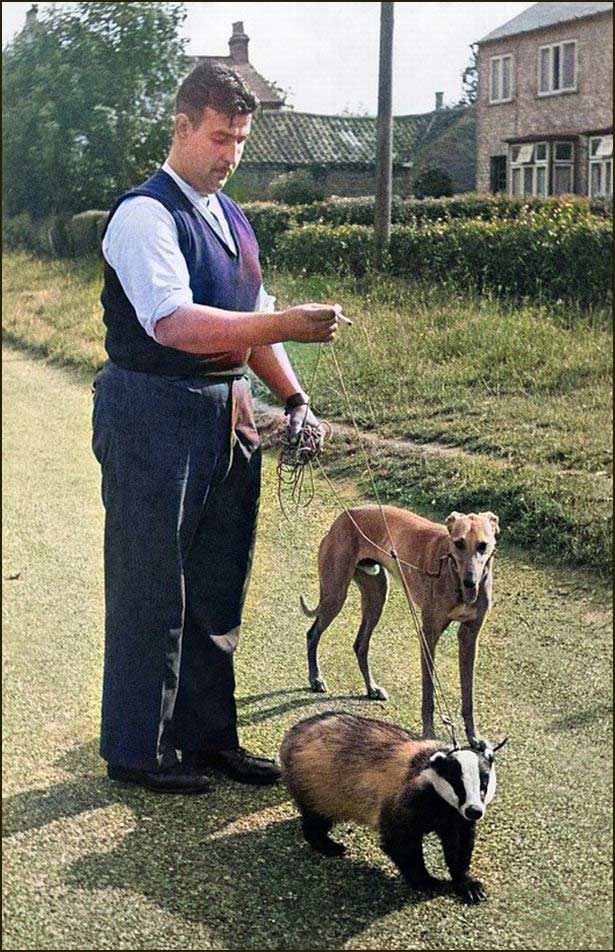
In years to come, Grove Cottage became the home of the youngest member of the Smith family, Harold, and following his death in 2021 at the age of 96, the reign of the Smiths at Grove Cottage came to an end.
In 2022 the house was sold.


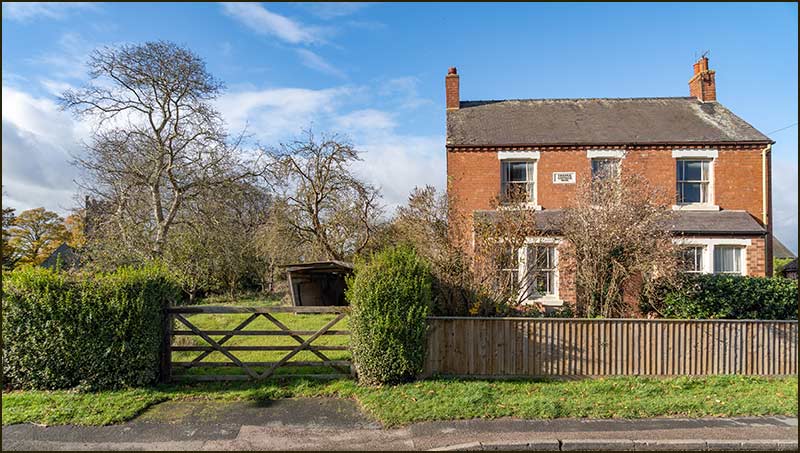
The paddock occupies the space between number 8 and number 12 Stockwell Lane.
A house was never built where the paddock is, but I suspect the houses were numbered to make room for a number 10 there – one day.

12 & 14 Stockwell Lane
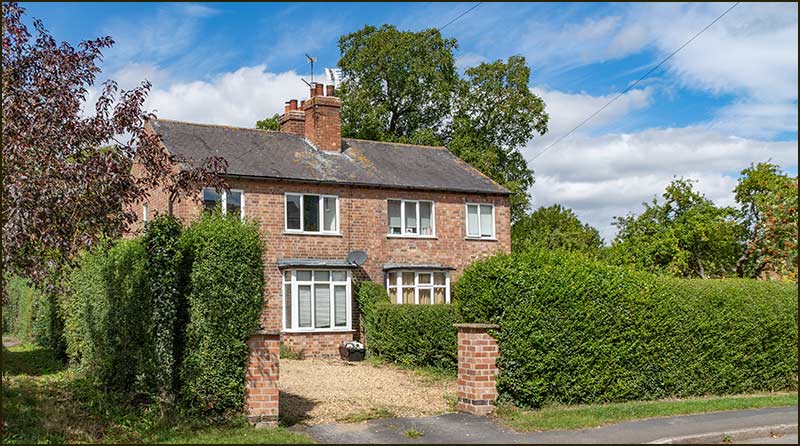
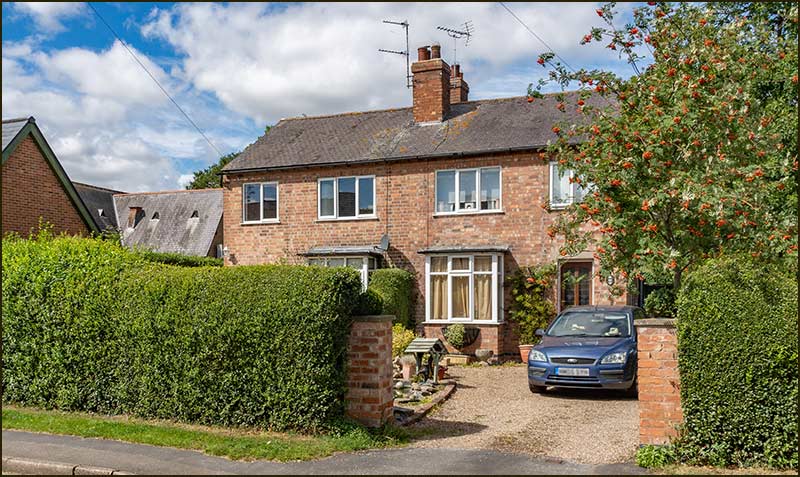

Top End
If you look back at the old maps of Stockwell Lane, you will only be able to link one building with the ones currently at the top end of the Lane. That will be the house with homes numbered 12 and 14.
The homes opposite 12 and 14 are obviously relatively recent additions: they were built in the late 1970s. As the old maps show, there was a building there before them - and it had to be demolished. It was an old vicarage.
As a home for the village vicar, you might expect there to be a long history of vicarages in all villages, but that is not the case.
In the distant past, a vicar would very often devote most of his time to personal pursuits rather than the well-being of his congregation. So much so, that he would not even live in the village or bother to visit it regularly. He would appoint all his church responsibilities to someone else, that someone being a curate.
Abraham Dobbin became the vicar of Cropwell Bishop in 1877 but, before that, he too had been a curate in Nottingham. The Cropwell Bishop vicarage that became his home, stood on ground where Dobbin Close now is - it is clearly marked on the 1930 map.
But before his vicarage was built, there had previously been another one in the village. It was not demolished but remained for almost a century after being cast aside by the church. That old vicarage was on Stockwell Lane, opposite 12 and 14 Stockwell Lane. It too is shown on the 1930s map.
It was there until the 1970s and here are photos taken at that time.

As you can see from the sign, "Cottage Style Chalet Houses" will take its place.
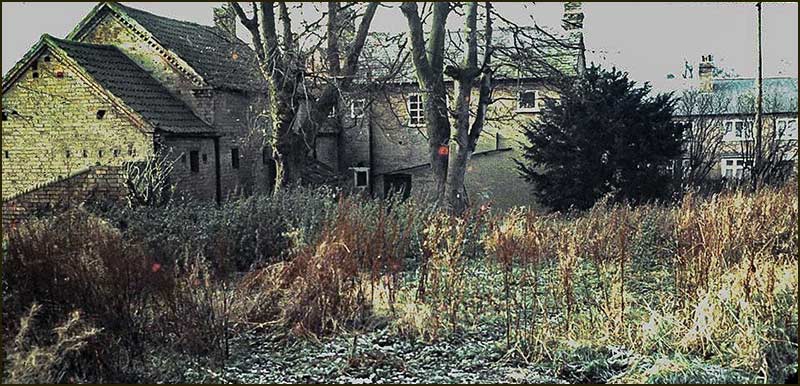
The two tree trunks belong to the tall trees in the previous picture.
You can see 12 Stockwell Lane in the background.
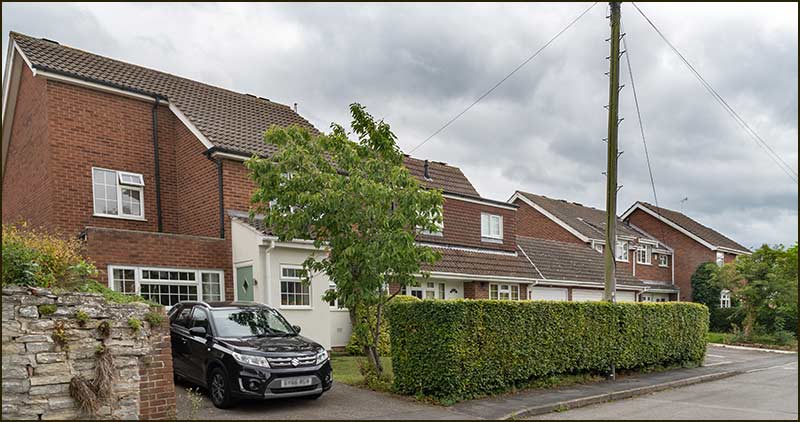


I imagine it would be a struggle to complain about mis-placed deliveries if you don't have a number on your house.


Note: Thanks to Anne Terzza, Pam Barlow, Pam Wregg and Muriel Baker for their help with this article.
Tony Jarrow
